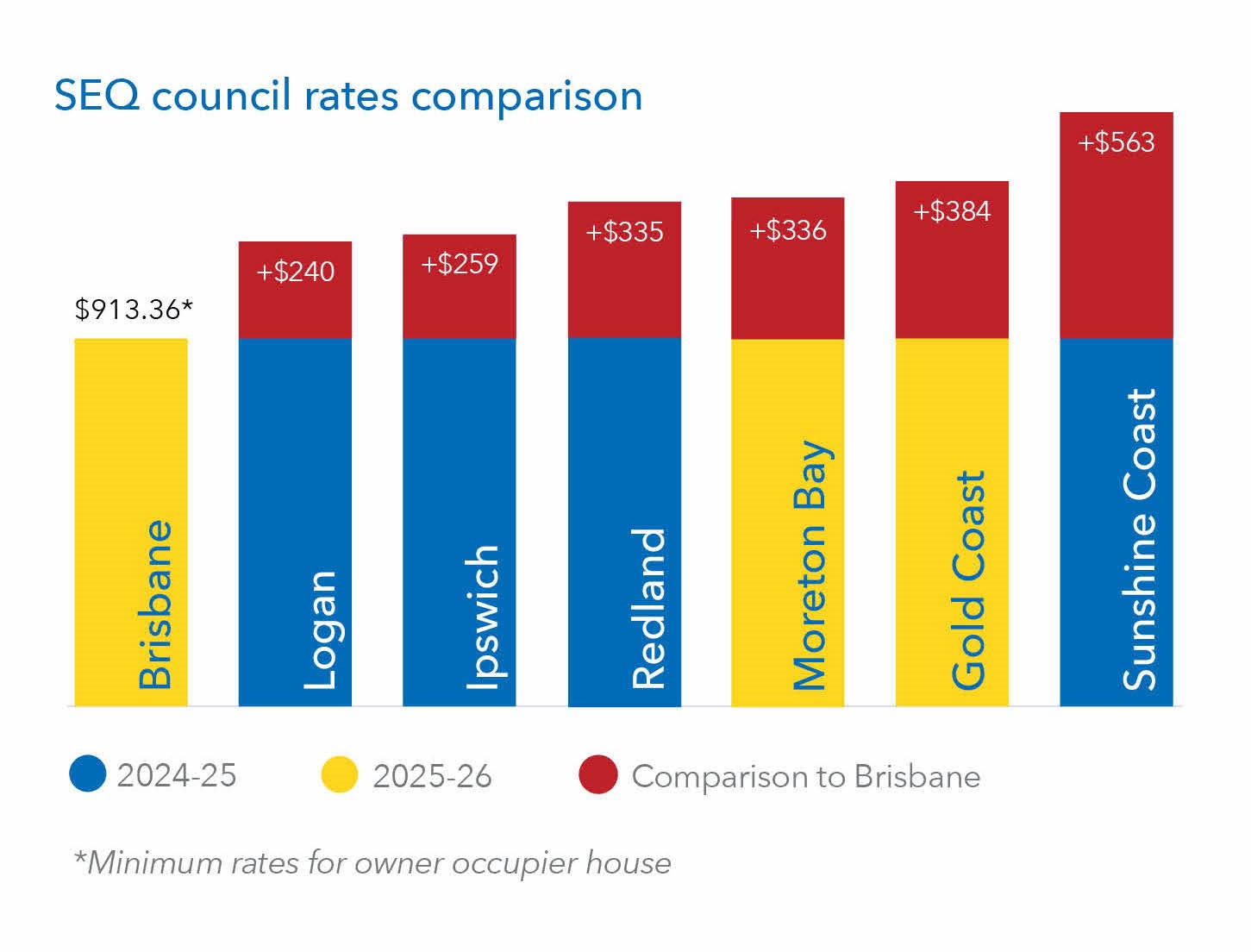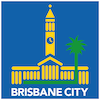
Brisbane residents get cheapest rates in south east Queensland
Brisbane residents get cheapest rates in south east Queensland
Brisbane residents will pay the cheapest rates in south east Queensland under the Schrinner Council’s balanced 2025-26 Budget.
This is a balanced and responsible Budget that ensures Brisbane rates are the lowest in south east Queensland while still delivering the infrastructure and services a fast-growing city needs.
We are committed to spending within our means, so we don’t add unnecessary costs onto residents now and into the future.
We’re striking the right balance between keeping costs down and keeping Brisbane moving.
This Budget ensures Brisbane residents continue to pay less than other councils but get more, with 85 per cent of the Budget invested in our suburbs where people live, work and relax.
Our team has experience running Australia’s largest local government and a proven track record of keeping costs down, with our net debt on track to reduce more than 20 per cent while other levels of government are increasing net debt by almost 290 per cent.
In stark contrast to our balanced and responsible Budget, the Green/Labor Coalition of Chaos made $3.5 billion in unfunded big spending promises which would have led to a rate rise of more than 30 per cent.”
General rates for owner occupied houses will increase by only $1.14 per week, or 3.87 per cent across the year.
Other south east Queensland councils are charging residents anywhere between $240 and $560 more per year in rates than Brisbane residents pay.
The gap between Brisbane and others Councils is likely to increase even more when their budgets are confirmed.
Unlike other Councils, Lord Mayor Adrian Schrinner also ruled out a new levy for Cyclone Alfred.
The Budget also includes a $50 increase to Brisbane’s maximum pensioner rebate scheme, which is already the most generous pensioner rebate in south east Queensland.
Pensioners will now be able to receive a rebate of up to $1298 a year.
The $60 on-time rates payment discount, which saved residents more than $16 million last financial year, remains.
The 2025-26 Schrinner Council Budget includes:
- Cost-of-living relief, including maintaining south east Queensland’s cheapest rates, return of $2 summer dips, continuation of free off-peak travel for seniors
- City-wide rollout of green bins to eligible houses who want one
- $500,000 donation to help Emmanuel City Mission establish a 24/7 homeless shelter in South Brisbane
- A huge 25 per cent funding increase for Suburban Community Events and Multicultural Festivals
- Building on record public transport investment with business cases for future metro stages: north to Carseldine, south to Springwood, east to Capalaba and the Brisbane Airport Metro
- Provide additional pay by app options for on-street parking to drive more convenience and choice
- Expanding Queen Street Mall along Albert Street, in conjunction with Cross River Rail
- Pool upgrades in Newmarket, Runcorn, Parkinson and the Valley
- Review of low-medium residential areas to deliver more homes
- Maintain the Housing Supply Incentive Policy’s 100 per cent infrastructure charge waiver for community housing providers. The 50 and 75 per cent incentives end 30 June 2025.
- Appointing Brisbane Sustainability Agency to protect and transform the Mt Coot-tha precinct
- Planting more trees in our parks and bushland reserves, with a focus on trees for koalas
- $1.9 million to plant new trees along transport corridor to Olympic and Paralympic Games venues
- Koala recovery, resilience and vaccinations program
- Boost Platypus by 2032 plan to protect and boost platypus populations
Under our plan we will drive down net debt by 21 per cent from $3.7 billion this year to $2.9 billion in 2028-29.
The State Government’s latest mid-year Economic and Fiscal Review, which represents State Labor’s last budget update, showed net debt would increase 287 per cent between 2024-25 and 2027-28. The Federal Government’s net debt is forecast to increase 28 per cent over the same period.
Of all taxes collected in Australia, councils collect just 3 per cent compared to Federal (81 per cent) and State (16 per cent) governments.
In the past 10 years State and Federal revenue has grown 77 per cent and 83 per cent respectively but financial assistance to Council has grown just over 13 per cent.
Local northside projects we have secured investment in to be delivered as part of the 2025-26 Schrinner Council Budget include:
Road or pedestrian upgrades at:
- Gregory Terrace, at Rogers Street, Spring Hill
- Creek Street, at Ann Street, Brisbane City
- Thomas Street at Edmonstone Road, Bowen Hills
- Alison, Balowrie, Castleton Streets, Hamilton
- Abbotsford Road, Albion
Blackspot projects to be delivered in partnership with the Federal Government:
- Gipps Barry, Fortitude Valley
- James, Doggett and Robertson Street, Fortitude Valley
- St Pauls Terrace and Quarry Street
Footpath improvements to take place at:
- Wharf Street, Brisbane City
- Charlotte Street, Brisbane City
- Constance Street, Fortitude Valley
- Eagle Terrace, Brisbane City
- Edward Street, Brisbane City
- George Street, Brisbane City
- MacArthur Av, Hamilton
- Sandgate Road, Albion
- Duke Street, Ascot
- Hudson Road, Albion
- Macarthur Avenue, Hamilton
Road resurfacing to occur at:
- Alice Street, Brisbane City
- Ann Street, Brisbane City/Fortitude Valley
- Boundary Street, Spring Hill
- Brookes Street, Fortitude Valley
- Kemp Place, Fortitude Valley
- McNally Street, Spring Hill
- Southwick Lane, Fortitude Valley
- Alison Street, Hamilton
- Balowrie Street, Hamilton
- Bridge Street, Wooloowin
- Castleton Street, Hamilton
- Charles Ulm Place, Eagle Farm
- Clark Street, Kalinga
- Clyde Gessel Place, Eagle Farm
- Harvey Street, Eagle farm
- Henry Street, Ascot
- Kedron Park Road, Wooloowin
- Lodge Road, Kalinga
- Main Beach Road, Pinkenba
- Racecourse Road, Ascot
- Roche Avenue, Bowen Hills
- Stewart Street, Clayfield
- Sword Street, Ascot
- Tingira Street, Eagle Farm
- Wallace Street, Albion
- Zillman Road, Hendra
Asset maintenance and upgrades which include:
- Boardwalk rehabilitation works at City Reach Admiralty Towers 2, Brisbane City
- Lighting and pathway upgrades at Centenary Place, Fortitude Valley
- Memorial restoration at Fountain Reserve, Brisbane City
- Refurbished toilet block at Oriel Park Ascot
- Replacement of bench seats at Newstead Park, Newstead
- Rehabilitation parkland at Northshore Riverside Park, Hamilton
Drainage and stormwater works at:
- Oxlade Drive, New Farm
- Carrol Lane, Spring Hill
- Wickham Street, Fortitude Valley
- East Street, Fortitude Valley
- Elystan Road, New Farm
- Creek, Charlotte, and Margaret Streets, Brisbane City
- Brunswick Street, New Farm
- Edward Street, Brisbane City
- McIntyre Street, Hendra

